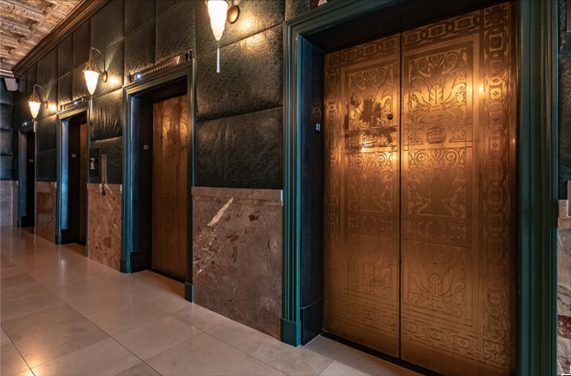Safety, Reliability, and Comfort: What Do Your High-Rise Tenants Think About Your Elevators?

Unless they work for a company like Mitsubishi Electric, you don't want your building's tenants and visitors thinking about your elevators. Elevators should be available with rides so safe and smooth the typical rider doesn't notice how easily they moved between floors. Tenants expect elevators to work and it's an unwelcome interruption when they don't. The occasional compliment is fine, but if you manage a high-rise, no news tends to equal good news when it comes to vertical transportation.
In our business, we obsess over giving riders nothing to report to property managers. Product ideation, design, engineering, installation, proactive maintenance, modernization —everything we do is geared toward helping tenants enjoy safety, comfort, reliability, and convenience. Below are five tips drawn from our experience to help property managers clarify and control the total cost of owning and operating elevators in high-rise buildings.
Tip 1: Recognize the costs of callbacks across maintenance, manhours, tenant satisfaction, and your building's reputation
Callbacks are incidents where an elevator has failed to operate as designed, and maintenance workers must perform diagnosis and repair. Whether callbacks are caused by a malfunction, user error, or vandalism, they are a common source of hidden costs beyond budgeted monthly maintenance fees.
As a property manager, you want to keep your costs predictable and transparent. But if elevator doors are knocked off the track, keys fall down a shaft, or user error results in an entrapment, you'll typically be charged a billable callback fee. Besides this unexpected charge, property owners also incur manhour costs as staff address elevator malfunctions. This may include hours for building engineers and front desk staff tasked with handling complaints. Also, less assertive tenants and visitors might not report issues to your team, but they could damage your building's reputation by expressing frustration and displeasure in their professional and social circles.
Tip 2: There's a difference between industry standards and superior performance
Modern elevators are safe, but some elevators exceed industry standards for reliability and performance. The current industry average is about four callbacks per elevator per year. Consider how much you can save by choosing elevator manufacturers and service providers to keep callbacks down to one call or less per unit per year.
Tip 3: Value preventative maintenance
Low callback numbers and costs require proactive, preventative maintenance. You can't go wrong if you start by selecting well-engineered elevators, but regular and thorough maintenance can catch potential issues early or prevent them altogether. Frequent routine observation, cleaning, lubricating, adjusting, and replacement of worn parts is the best way to maintain reliability and increase the lifespan of your vertical transportation equipment. Some leading elevator manufacturers offer robust preventative maintenance programs able to deliver superior reliability for third-party elevators in addition to their own.
Providers who achieve low callback numbers due to preventative maintenance spend less time responding to unscheduled maintenance calls. This enables them to provide a higher degree of attention to each property compared to providers with unpredictable schedules who jump from emergency to emergency.
Tip 4: Take advantage of modernization programs
Depending on the manufacturer and service provider, elevators can have a service life from 20 to 40 years. However, even if you have an elevator with a longer than typical service life, core components such as traction machines and control equipment inevitably deteriorate. With a modernization program from an elevator manufacturer or service provider, you can update your elevator's components before wear and tear results in unexpected repair costs or equipment failures. Leading manufacturers with long elevator lifecycles continue manufacturing parts for the life of the machine and can help property owners keep their elevators up-to-date with innovative technologies and product improvements to meet evolving standards, markets, and tenant expectations for safety, reliability, convenience, and comfort.
Tip 5: Stay up-to-date on current technologies for improving safety, car availability, and the rider experience
Since the start of the COVID-19 pandemic, your tenants have become more thoughtful and cautious about how germs spread. Elevator manufacturers have responded with solutions designed to increase hygiene and give riders less to think about in terms of vectors for infection. These solutions include touchless hall panels and smartphone applications to reduce the need to interact with elevator fixtures. You'll want to discuss your options with elevator consultants and service providers who can advise you on touchless rider interfaces. Elevator consultants can also walk you through how the rider experience and your elevator's performance can be improved by destination dispatch systems for reducing travel and wait times and variable-voltage, variable-frequency (VVVF) inverters, intelligent door systems, and active roller guides for precise control of movement and operation.
Our elevator pitch
When it comes to elevators, excellence is often "invisible." Tenants might not comment on your elevators' performance and comfort if they can take it for granted, but your total cost of ownership will tell the story loud and clear. To learn more about reducing callbacks, maintaining predictable monthly costs, modernization, and meeting tenant expectations for safety, reliability, convenience, and comfort, visit mitsubishielevator.com and schedule a time to chat with a vertical transportation expert.
This guest blog post was provided Mitsubishi Electric US, Inc. Elevator/Escalator Divisions. Visit their website to learn more about their services.

